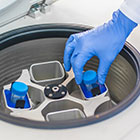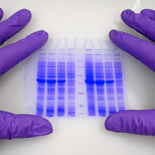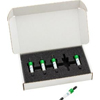Protein Purification Methods: A Comprehensive Overview
The basic aim in protein purification is to isolate one particular protein of interest from other contaminating proteins to study its structure and function. This page will provide an overview of the importance of protein purification in science, methods used by biomanufacturers, the role it plays in the search for life saving solutions - and how Avantor can provide the support and guidance you may need.
Featured Suppliers

Pall Laboratory leader in filtration, separation & purification
Specializing in Filtration and Sample Preparation Solutions for Cellular, Molecular, Analytical, Micro Applications and More!

BAKERBOND® PROchievA™ is optimized to deliver top performance
Enhance your separation power and increase product purity with the J.T.Baker® BAKERBOND® PROchievA™ protein A derived affinity chromatography resin.
Sample preparation

Protein Electrophoresis

Purification
Concentration
Featured Products

Agilent Multiple Affinity Removal Columns
High-abundant protein depletion columns

J.T.Baker® BAKERBOND® PROchievA
The J.T.Baker® BAKERBOND® PROchievA™ recombinant protein A resin offers superior dynamic binding capacity with excellent alkaline stability linked to Avantor's proprietary ligand.

Pall AcroPrep™ 24-Well Filter Plates
Comprehensive range of higher sample volume filter plates ranging from ultrafiltration through particle filtration. 1 - 100K, 0.1 - 5μm & 30/40μm pore sizes

Pall Minimate™ EVO TFF
NEW - Laboratory scale Tangential Flow Filtration system for concentration, desalting, and buffer exchange processes

Cytiva™ Whatman™ PolyVENT Integral vent filters
Prevent bacterial contamination in sterile venting of vessels, fermentors, and tanks with Whatman™ PolyVENT bi-directional, sterile vent filters.
What is protein purification?
- Overview: Protein purification can be defined as a series of steps that are carried out in order to obtain and study the desired protein from a complex mixture. Proteins play an integral role in cell structure and function. Isolating a protein will help in the analysis of the protein’s features such as the following:
- Size and structure
- Binding affinity
- Biological activity
- Physio-chemical properties
- Protein-protein interactions
Downstream processing in protein purification
Downstream protein purification is the final stage in bio-therapeutic manufacturing. It’s the point when the target protein is harvested and purified
To explain further, downstream processing is the series of operations required to take biological materials such as cells, tissue culture fluid, or plant tissues, and derive from them a pure and homogeneous protein product.
Because the product is initially trapped in a biological matrix with a vast and diverse array of non-target molecules, DSP is a multi-step process that incrementally increases the purity of the target by exploiting the physical and chemical properties that make it distinct from contaminants.
DSP involves harvesting and clarification steps to remove bulk contaminants such as particulates, carbohydrates, and oils followed by capturing and polishing steps that refine the feed stream -- until only the target product remains.
Trust Avantor’s experts to help you reduce downstream turnaround times in the biopharma monoclonal antibody (mAb) production process. Contact us for protein purification guidance by using this simple form.
4 Protein purification methods
Protein purification can be viewed as a combination of steps where the protein progresses in purity with each step.
To purify a protein, one must begin with the starting material and fractionate it using any one of a large number of physical or biochemical approaches . The initial material can be separated into fractions using accepted approaches like those discussed below
Upon extraction from the source, Centrifugation is done to isolate the proteins. Lastly, fine-resolution techniques such as chromatography provide the final product.
Method # 1. Extraction:
Depending on the source, the protein has to be brought into solution by breaking the tissue or cells containing it. There are several protein purification methods to achieve this:
- Repeated freezing and thawing,
- Sonication,
- Homogenization by high pressure; or
- Permeabilization by organic solvents.
The method of choice depends on how fragile the protein is and how sturdy the cells are.
Method # 2. Precipitation and differential solubilization:
In bulk protein purification, a common first step to isolate proteins is precipitation with ammonium sulphate. This is performed by adding increasing amounts of ammonium sulphate and collecting the different fractions of precipitate protein.
One advantage of this method is that it can be performed inexpensively with very large volumes.
Method # 3. Ultracentrifugation:
Centrifugation is a process that uses centrifugal force to separate mixtures of particles of varying masses or densities suspended in a liquid. When a vessel (typically a tube or bottle) containing a mixture of proteins or other particulate matter, such as bacterial cells, is rotated at high speeds, the angular momentum yields an outward force to each particle that is proportional to its mass.
The net effect of “spinning” the sample is that massive, small, and dense particles move outward faster than less massive particles or particles with more “drag” in the liquid.
Method # 4. Chromatographic methods:
Usually a protein purification protocol contains one or more chromatographic steps. The basic procedure in chromatography is to flow the solution containing the protein through a column packed with various materials. Different proteins interact differently with the column material, and can then be separated by the time required to pass the column.
Protein extraction in protein purification
The process of protein extraction starts with very crude samples that are cleaned up through filtration, centrifugation, solubilization and precipitation, and refined with techniques such as affinity columns and immunoprecipitation. Here is a generally accepted workflow:
- Lyse cells by sonication or homogenize tissue by freezing and grinding or homogenizing. This process breaks cell walls and frees proteins into the sample. Tissue samples can then be filtered to remove large debris.
- Centrifuge sample to remove cellular debris. This is usually performed in an ultracentrifuge via differential centrifugation or density gradient centrifugation. This step can be particularly useful for extracting specific compartmental proteins such as exosomal proteins.
- Re-suspend sample in an appropriate protein extraction buffer. This buffer will contain an appropriate amount of salt, will contain a buffering agent to maintain pH 6-8, and will contain any necessary detergents, reducing agents, denaturants, or protease inhibitors.
- Bio-magnetic separation may be used as an optional step for further refinement of target protein solution. This technique is able to specifically enrich target protein due to a “lock-and-key” match between the target protein and the capture protein conjugated to magnetic nanoparticles.
- Measure protein concentration via absorbance at 280 nm, Lowry Assay, Bradford Assay, or Bicinchoninic Assay (BCA) • Store protein extract at -80ºC or -20ºC until needed for further analysis.
Precipitation and differential solubilization
Differential protein precipitation is a rapid and economical step in protein purification and is based on exploiting the inherent physicochemical properties of the polypeptide. Precipitation of recombinant proteins, lysed from the host cell, are commonly used to concentrate the protein of choice before further polishing steps.
Ultracentrifugation
This process uses centrifugal force to separate mixtures of particles of varying masses or densities suspended in a liquid. When a vessel (typically a tube or bottle) containing a mixture of proteins or other particulate matter, such as bacterial cells, is rotated at high speeds, the angular momentum yields an outward force to each particle that is proportional to its mass.
The tendency of a given particle to move through the liquid because of this force is offset by the resistance the liquid exerts on the particle. The net effect of “spinning” the sample in a centrifuge is that massive, small, and dense particles move outward faster than less massive particles or particles with more “drag” in the liquid.
Chromatographic methods
Currently, there are a broad range of next-generation sorbents and membranes available for chromatography. These new chromatography media are characterized by significantly improved performance compared to their classical predecessors such as:
- Higher dynamic binding capacities,
- Higher operational flow rates, and
- Specific and distinctive retention mechanisms.
Nevertheless, traditional media (based on agarose or polymers) continue to be routinely used due to their proven suitability for protein purification in FDA- or EMA-approved applications. Practical experience shows that the optimization of individual process steps (capture, purification, and polishing) offers important cost reductions. But it is mainly through a combination of all sorbent- and membrane-based unit operations deployed in downstream processing that the door is opened for effective process cost savings.
6 Chromatographic methods in protein purification
At present, there are a number of chromatographic methods that can be utilized in purifying protein samples, some of which include:
- Size Exclusion Chromatography: Chromatography can be used to separate protein in solution or denaturing conditions by using porous gels. The principle is that smaller molecules have to traverse a larger volume in a porous matrix. Consequentially, proteins of a certain range in size will require a variable volume of eluant (solvent) before being collected at the other end of the column of gel.
- Ion Exchange Chromatography: Ion exchange chromatography separates compounds according to the nature and degree of their ionic charge.
- Affinity Chromatography: Affinity Chromatography is a separation technique based upon molecular conformation, which frequently utilizes application specific resins. These resins have ligands attached to their surfaces which are specific for the compounds to be separated.
- Metal Binding: A common technique involves engineering a sequence of 6 to 8 histidines into the C-terminal of the protein. The polyhistidine binds strongly to divalent metal ions such as nickel and cobalt. The protein can be passed through a column containing immobilized nickel ions, which binds the polyhistidine tag. All untagged proteins pass through the column.
- Immunoaffinity Chromatography: Immunoaffinity chromatography uses the specific binding of an antibody to the target protein to selectively purify the protein. The procedure involves immobilizing an antibody to a column material, which then selectively binds the protein, while everything else flows through.
- HPLC: High performance liquid chromatography or high pressure liquid chromatography is a form of chromatography that applies high pressure to drive the solutes through the column faster. This means that the diffusion is limited and the resolution is improved.
Affinity tags for protein purification
What is Tagged protein purification?
- Tagged protein purification uses affinity chromatography (AC) to purify recombinant proteins that have been engineered to include a specific peptide or protein sequence (tag).
- Common choices for protein affinity tags are polyhistidine (histidine-tag), glutathione S-transferase (GST), maltose-binding protein (MBP), Strep-tag® II, and FLAG™ tags. His-tagged proteins are purified with a variant of affinity chromatography called IMAC (immobilized metal affinity chromatography).
- Tags simplify purification and enable scientists to use standard protocols. It improves the yield, purity, and solubility of the protein of interest, and minimizes the number of purification steps needed. You can also use tags for detection.
- “Affinity tags” are unique proteins/peptides that are attached at the N- or C-terminus of the recombinant proteins. These tags help in protein purification. Additionally, some affinity tags also serve a dual purpose as solubility enhancers for challenging protein targets.
Pull-down methods for protein complexes
Definition
The pull-down assay is an in-vitro technique used to detect physical interactions between two or more proteins and an invaluable tool for confirming a predicted protein-protein interaction or identifying novel interacting partners.
Purpose
Protein interactions reveal a lot about how proteins and cells function under different conditions. A pull-down assay allows us to look at direct protein interactions and utilizes a bait protein bound to beads in a column to catch protein binding partners.
This technique can be used to verify a predicted protein interaction via Western blot or identify novel protein interactions using a total protein stain.
Pull down assays can be used to identify novel protein interactions or assess how proteins bind under different conditions for any number of diseases -- or simply provide information that can offer a better picture of what’s happening in the inner world of cells.
1. Affinity pull-down assay
Definition
Pull-down assays involve isolation of a protein complex by adsorbing the complex onto beads. Immobilized ligands on the beads bind specifically to a component of the complex, either via an affinity tag (e.g., GST, histidine, maltose binding protein, etc.) or an antibody.
Pull-down assays are important tools for mapping protein-protein interaction networks. They have been successfully used on a global scale to map protein-protein interactions in a number of organisms (e.g., yeast, E. coli, C. elegans).
Process
Design of the appropriate controls for the experiment are essential.
Affinity pull-down assays are well established for the isolation and subsequent identification of protein complexes. GST pull-down assays involve affinity purifications of one or several unknown proteins from a biological sample using a GST-tagged bait protein.
The basic principle is that the GST-tagged bait protein binds to its partners, and the resulting complex is captured on beads with immobilized glutathione. A control is included to identify false positives that bind to GST in the absence of a bait protein.
The control can either be lysate from separately transformed cells that express GST (not the bait fusion protein) or lysate from non-transformed cells to which GST is added.
2. Tandem affinity purification
Definition
Tandem Affinity Purification, (or “The TAP method”) with or without modifications, has been used to purify and identify complexes from yeast, trypanosomes, fruit flies, humans, and plants.
TAP employs two successive affinity chromatography steps to isolate protein complexes. The rationale behind the use of two affinity steps is to enhance the specificity of the purification procedure and hence reduce the number of false positives. Furthermore, the conditions used throughout this method are mild -- in order to preserve complex integrity and to maximize yield. The method has been used successfully in many cases.
Process
A bait protein (a known or suspected complex component) is tagged with both protein A and calmodulin binding peptide (CBP) with a tobacco etch virus (TEV) protease cleavage site between the two tags.
The double-tagged bait protein is expressed at near natural levels, since overexpression may trigger non-physiological interactions. The complex is first adsorbed to IgG Sepharose beads, via the protein A tag, and eluted by cleavage with TEV.
3.Identifying Protein Interactions via Co-immunoprecipitation
Definition
Immunoprecipitation is a well-established technique that uses antibodies to isolate antigens from crude biological samples.
The name is historical and originates from analysis methods based on the precipitation reaction obtained when mixing antibody and antigen at the correct ratio.
Overview
Co-immunoprecipitation uses antibodies directed towards one (known or supposed) component of a complex. The antibody binds to its antigen, which is part of a multiprotein complex. The antibody-protein complex assembly is then captured through the addition of protein A or protein G Sepharose beads to the mixture.
Downstream optimization in protein purification
The ultimate goal in the downstream optimization of recombinant proteins and other biologics is to improve recovery and reduce the cost per gram of protein produced.
This requires producing more drug product, in less time, and with the same amount of resin and buffer material. Biomanufacturers can achieve this by making better use of the newest generation of mixed-mode and multimode resins and more efficient buffer management practices.
Avantor’s services teams can work closely with you to identify biopharma scale-up bottlenecks, streamline production processes, and improve efficiency and productivity so you can shorten time to market for life-saving solutions.
See our services page for more valuable information about downstream optimization.
From pre-clinical through commercial manufacturing, Avantor works closely with biopharmaceutical customers to reduce downstream optimization turnaround times so biopharmaceutical customers can reach the market faster with new therapeutics.
Ready to get started? Contact your Avantor account manager to take the next step.
 Application Notes
Application Notes
 Literature
Literature

